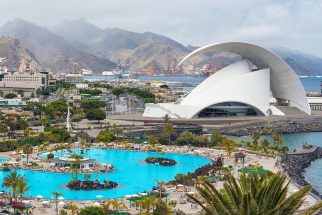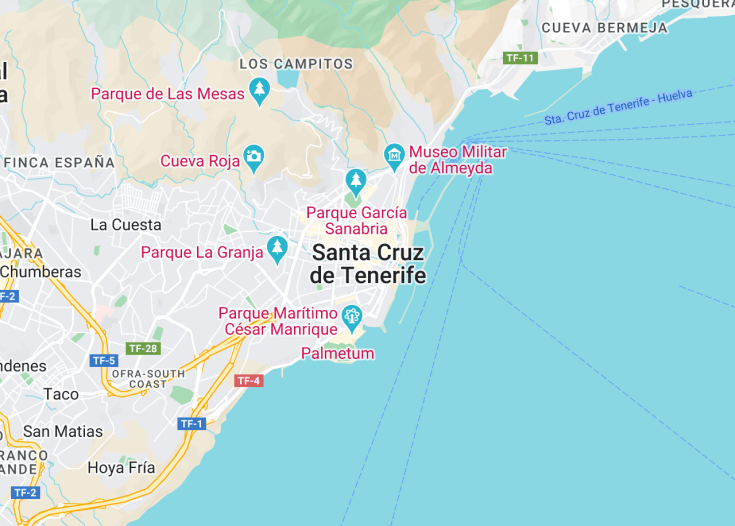Santa Cruz de Tenerife, the vibrant capital of the Canary Islands, offers a bustling cosmopolitan lifestyle against a backdrop of timeless scenery. Dominated by the majestic Mount Teide, this city boasts stunning architecture, lush green spaces, and a rich cultural heritage. Visitors can explore the historic streets, enjoy local cuisine, and experience lively festivals year-round. With its gentle climate and welcoming atmosphere, Santa Cruz de Tenerife presents a perfect blend of natural beauty and urban charm.
When visiting, take the opportunity to attend a live performance at the iconic Auditorio de Tenerife, a masterpiece of contemporary architecture.
Don’t miss exploring the nearby Anaga Rural Park, where ancient forests and picturesque villages provide a tranquil escape from the city life.
Top things to do & see in Santa Cruz de Tenerife
Select the following sights and activities to discover best tickets and tours available in Santa Cruz de Tenerife.
Santa Cruz de Tenerife: A Canary Gem
| Country | Tenerife (Canaries, Spain) |
| Time in Santa Cruz de Tenerife | GMT |
| Language spoken | Spanish |
| Population | 207,312 (source: latest census data) |
| Currency | Euro (€, EUR) |
| Airports |
|
Santa Cruz de Tenerife plays a central role in Tenerife’s culture and history as its capital city. Positioned on the northeastern tip of the island, it serves as the bustling heart of activity with a lively blend of historical elements and modern influences. The city’s strategic position in the Canary archipelago has historically made it an important port town. Today, it thrives as a cultural hub, hosting numerous festivals, museums, and theaters. Santa Cruz de Tenerife offers visitors and residents alike a dynamic cityscape marked by the Auditorio de Tenerife, the Museo de la Naturaleza y el Hombre, and beautiful parks such as Parque García Sanabria. The city’s history dates back to the late 15th century when it was founded by the Castilians after they conquered the island. The city’s natural harbor contributed to its development as a key trading post between Europe, Africa, and the Americas. Santa Cruz de Tenerife is also known for the vibrant Carnival of Santa Cruz, one of the world’s largest and most spectacular. Besides its festive atmosphere, it’s also a city of great architectural significance, showcasing a mix of traditional Canarian styles and contemporary architectural designs. Its position as a port city has attracted a mix of different cultures over the centuries, contributing to a diverse and vibrant community. This cultural melting pot is reflected in its varied gastronomy, local customs, and daily life, making it a fascinating destination. Furthermore, it serves as the political and economic center of Tenerife, influencing the entire Canary Islands region.
Where is Santa Cruz de Tenerife?
Santa Cruz de Tenerife is located on the northeastern coast of Tenerife, the largest of Spain’s Canary Islands, positioned off the northwest coast of Africa.
Distances:
| Route | Distance by car | Time by car |
|---|---|---|
| Tenerife – Santa Cruz de Tenerife | 43 mi / 69 km | Approx. 1 hour |
| San Cristóbal de La Laguna to Santa Cruz | 6 mi / 9.7 km | Approx. 15 mins |
What is Santa Cruz de Tenerife famous for?
Santa Cruz de Tenerife is renowned for its vibrant Carnival, considered one of the most spectacular in the world. It’s also known for its beautiful beaches, lush parks, and significant historical sites, making it a key cultural and tourist center in the Canary Islands.
History
The enchanting city of Santa Cruz de Tenerife, not just a modern metropolis but a canvas of rich historical tapestries, offers a compelling journey through time. From its early occupants to its bustling present, Santa Cruz’s past is a pivotal element in understanding its culture and significance.
Pre-Spanish Era (before 1494)
Before Spanish conquest, the island of Tenerife was inhabited by the Guanches, the indigenous people thought to have arrived from North Africa. These early settlers established a primitive lifestyle primarily based on goat herding and agriculture in the fertile regions of the island.
Spanish Conquest and Settlement (1494 – 1700)
The strategic importance of Tenerife in the Atlantic made it an invaluable asset for the Spanish Empire following its conquest by Alonso Fernández de Lugo in 1494. Santa Cruz de Tenerife was initially a humble settlement, which served as a critical port in the Atlantic sea routes. Over the centuries, it grew in prominence, particularly after becoming a crucial site in the battle against British privateer Sir Francis Drake in 1589.
Commercial Boom and Fortifications (1701 – 1899)
The 18th and 19th centuries marked a period of significant economic growth and architectural development in Santa Cruz de Tenerife. The city became an essential commercial hub, connecting Europe with the Americas. This era also saw the construction of several fortifications to defend the city against frequent pirate attacks and military incursions, most notably the Battle of Santa Cruz de Tenerife in 1797, where Admiral Horatio Nelson lost his arm.
Modern Era (1900 – Present)
In the 20th century, Santa Cruz de Teneriefe witnessed substantial social and economic changes, transitioning from a fortified port to a buzzing capital. The city played a crucial role during the Spanish Civil War and saw considerable growth in the post-war era. Today, it stands as a vibrant city known for its cultural festivals, historical landmarks, and dynamic economy, seamlessly blending its rich historical past with a modern lifestyle.
Visit Santa Cruz de Tenerife
What to see and do in Santa Cruz de Tenerife
Exploring Santa Cruz de Tenerife is a delightful experience, offering a mix of cultural, historical, and modern attractions:
- Auditorio de Tenerife: A symbol of contemporary architecture designed by Santiago Calatrava.
- Plaza de España: The largest square in the city, surrounded by important buildings and with a central lake.
- Museo de la Naturaleza y el Hombre: Explore artifacts of the Guanches and learn about the natural history of the Canaries.
- Playa de las Teresitas: A stunning man-made beach perfect for a relaxing day out.
- Parque García Sanabria: A large municipal park that contains beautiful sculptures, fountains, and lush plant life.
Cultural Festivities in Santa Cruz de Tenerife
Santa Cruz is renowned for its vibrant events, notably:
- Carnival of Santa Cruz de Tenerife: One of the world’s largest and most spectacular carnivals, held annually in February or March.
- Fiestas de Mayo: Celebrations including traditional music, dance, and Canarian wrestling, commemorating the founding of the city in May.
- Festival de Músicas Mestizas y +: A newer event showcasing a fusion of various musical genres every September.
</1>
Best time to visit Santa Cruz de Tenerife
The best time to visit Santa Cruz de Tenerife is during the spring, from March to May, and in autumn, from September to November. These periods offer pleasant weather, fewer crowds, and lower accommodation rates, making it an ideal time for tourists to explore and enjoy the city.
is Santa Cruz de Tenerife worth visiting?
Santa Cruz de Tenerife, with its rich cultural heritage, modern architectural wonders, and lively festivals, offers a unique blend of experiences that make it worthwhile for any traveler. While the city can be crowded during major festivals, and summer months may bring higher temperatures, its wide range of attractions from historical sites to natural beauty, provide ample reasons to visit. The city’s cosmopolitan vibe mixed with traditional elements ensures a memorable visit, appealing to both history buffs and those seeking a dynamic urban atmosphere.










